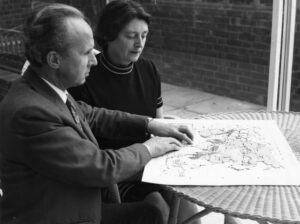Join a powerful, unprecedented alliance for better eye health for all.
Join IAPB-
Choose an alternate language here
Lady Jean Wilson, Vice President and co-founder of Sightsavers is 100 years old this month. She has been an energetic campaigner for the prevention of avoidable blindness and a pioneering champion of the rights of people with disabilities for most of her life.
Jean and her husband Sir John Wilson set up Sightsavers in 1950 with an aim of advancing the rights of people with visual impairments. John had been blinded at the age of 12 by an accident in a chemistry class at school and learned through personal experience that there is a stigma attached to blindness, particularly in Africa and Asia.
The couple travelled in Africa for six weeks in 1950 and visited communities known as ‘villages of the blind’, gaining a greater understanding of the impact of these issues. It was on this trip that Lady Jean first encountered onchocerciasis, a disease which causes severe skin irritation and itching and, eventually, irreversible blindness. At the time it was one of the main causes of blindness across West Africa. There she famously coined a new name for the disease, ‘river blindness’, now in common use. It is a source of great joy to Jean that we are now able to control river blindness with donated Mectizan.
In the early days the organisation was run from a tiny office in London, with three members of staff. Now, Sightsavers is a global organisation, working with governments and partners in over 30 countries. We have supported the delivery of over 1.5 billion neglected tropical disease (NTD) treatments,8.5 million cataract operations, and helped more than 289,000 people with disabilities live full and independent lives.
Jean talks fondly about early fundraising and advocacy efforts. One of her favourite memories is the climb of Mount Kilimanjaro by seven blind men and she is rightly proud of a quote from an African newspaper which says: “these blind men, by their skill and courage have opened the eyes of Africa”. She said to me: “It meant that parents of blind children begin to think, if a blind man can get to the top of that mountain, it might be worth sending my child to school after all”.
Over the years, Sir John’s advocacy work became more and more prominent and his and Jean’s international reputation grew alongside recognition of the cause. This led to Sir John becoming the Founder President of IAPB in 1975. He remained in this role, and as Executive Director of Sightsavers, with Jean by his side, until 1983.

It was in that year that the UN declared 1983 – 1992 as the ‘UN Decade of Disabled Persons’, and this led Sir John and Lady Jean to set up the IMPACT Foundation, focusing on all people with disabilities around the world.
Jean has been involved with Sightsavers, IMPACT and other organisations such as the Hearing Conservation Council throughout her life, and she still helps us campaign to this day. Only a few years ago she was still making trips to Geneva to meet with WHO on hearing issues.
I have always enjoyed spending time with Jean, whose acute mind and wealth of experience is always so impressive. I am particularly impressed by the fact that she always looks to the future. It was Jean who helped us change our charter documents to enable us to work beyond blindness and encompass work on wider NTDs and support and campaign for people with disabilities.
I look forward to celebrating with Jean around her birthday and hope she enjoys happy events with her wonderful family, including eight great grandchildren.
She has an incredible legacy including making a difference to millions of lives, and neither Sightsavers nor IAPB would exist without her.
Image on top: Lady Jean Wilson talks to Sightsavers staff at an event to celebrate the distribution of 1 billion treatments for neglected tropical diseases in 2017/ Copyright: Simon Way/Sightsavers